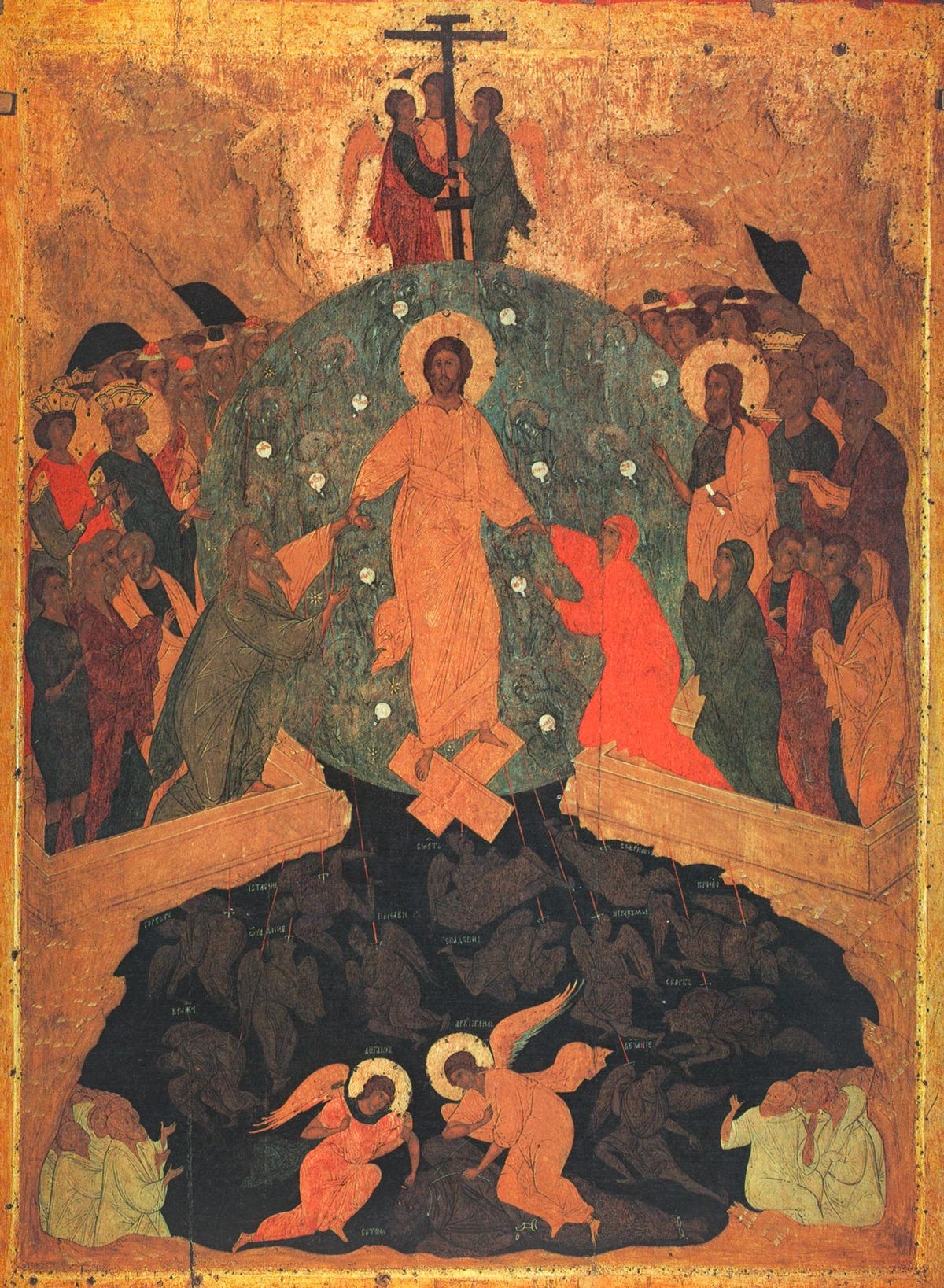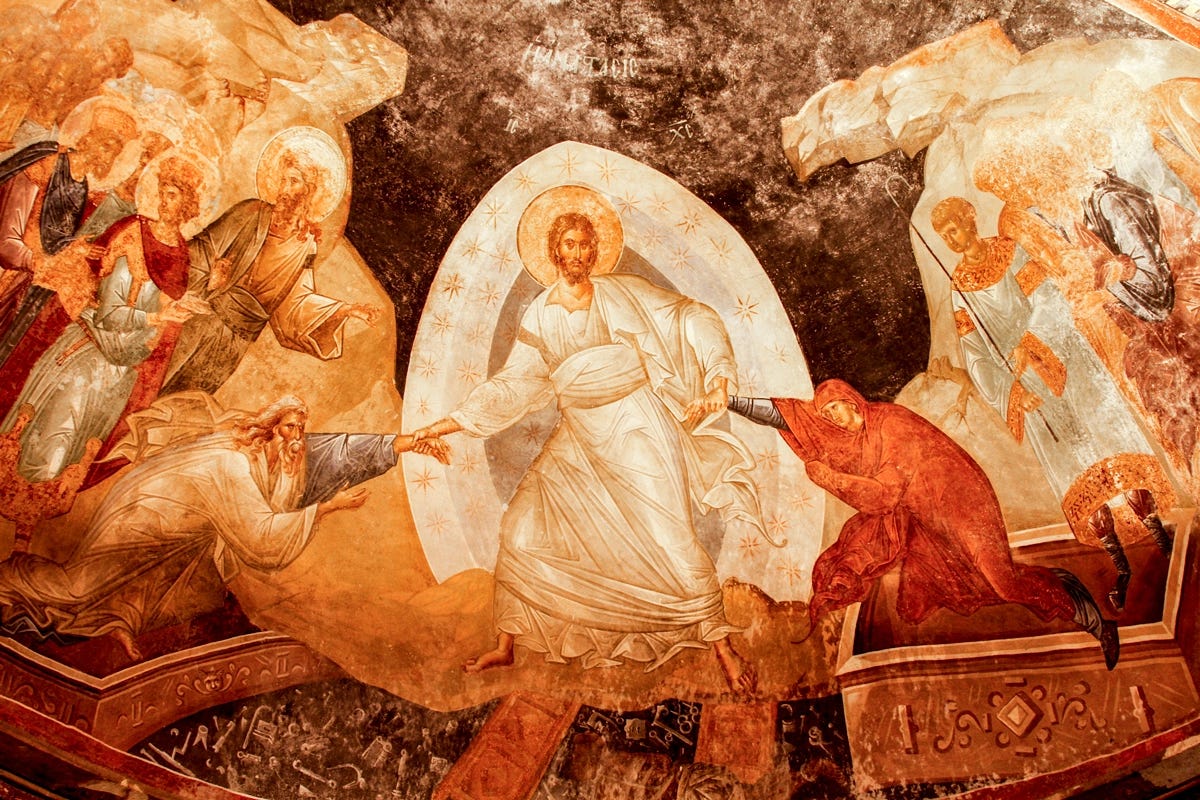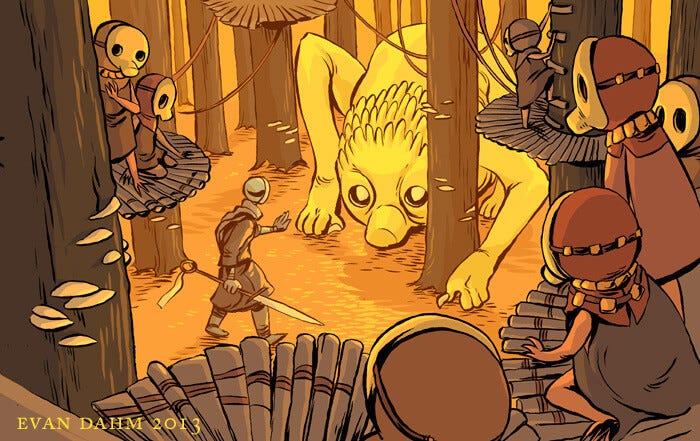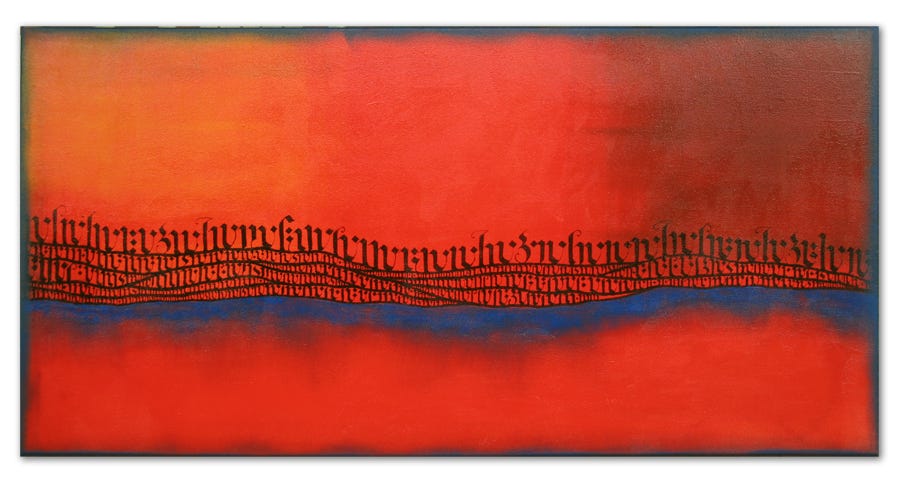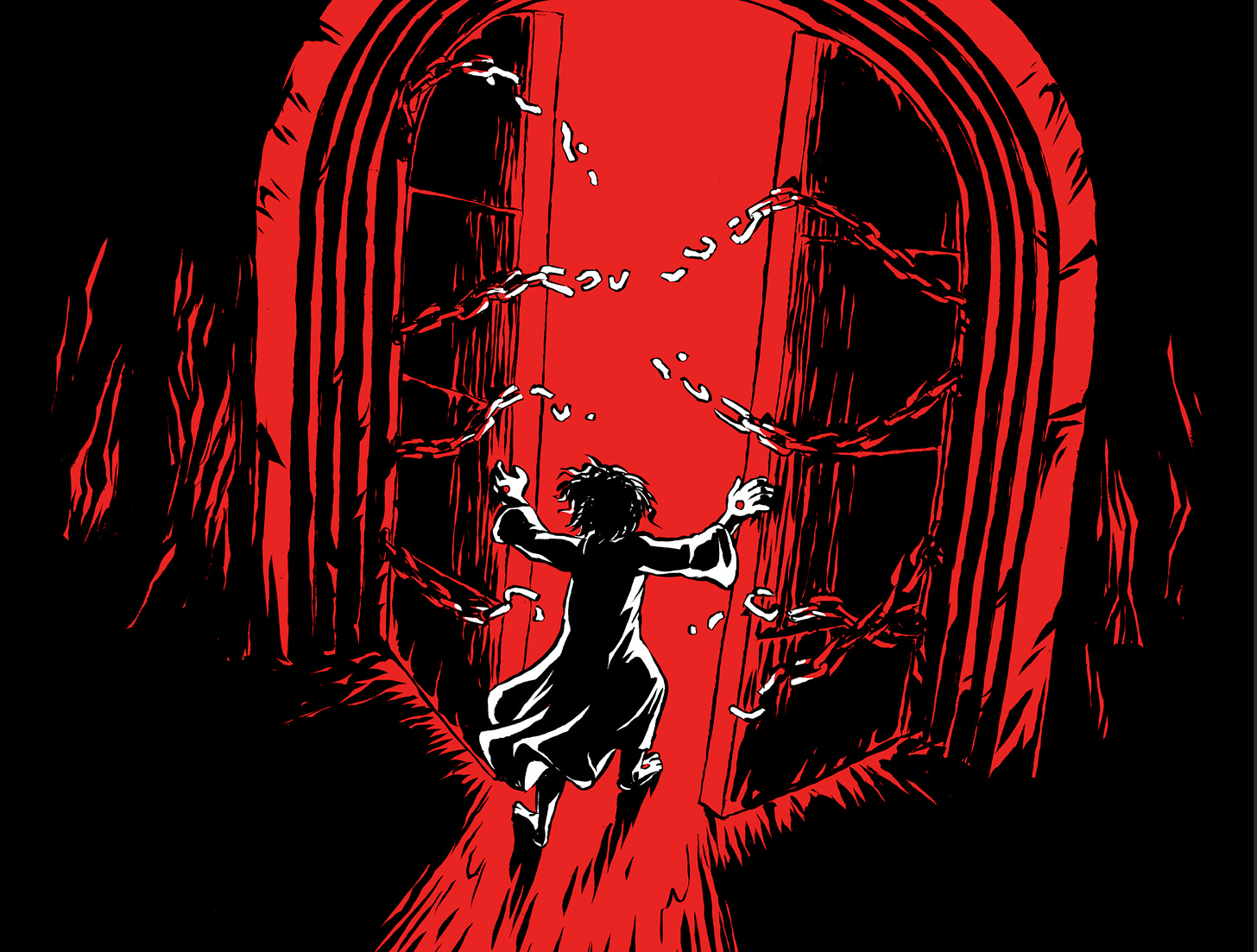[SPOILER WARNING FOR THE BOOK]
[Apologies to The Comics Journal for quoting them so liberally, there were so many thought provoking quotes. Everyone should be reading TCJ more. Full list of citations at the end. Biographical information mostly comes from Dahm’s website and Wikipedia, and the ancient art comes from Google Images and Wikipedia.]
This last month I had the great pleasure to reread a book that is important not only for fans of political comics, but also Christians, those intrigued by the potential of comics to discuss religion, and those looking to explore theopoetics of Christian Anarchism.
That book is the 2020 graphic novel The Harrowing of Hell, by Evan Dahm. Visually and thematically intense, this 130-page comic book is great for people who like creative Biblical fiction in the vein of Scorsese and political theologies in the vein of Jaques Ellul.
It adapts the story of Jesus’s descent into the pit, which is briefly alluded to in the Apostles’ creed, referenced in some of the Canonical Gospels, and explored more fully in the Gnostic Gospel of Nicodemus/The Acts of Pilate. This story has also been represented by artists of a wide variety, each putting their own spin on how they imagine Christ, Hell, and the other people in the story to appear, whether they profess a belief that these events occurred literally or are entirely fictional. It also has acted as a wide canvas for people to project their ideas about sin, martyrdom, salvation, and Jesus’s politics for millennia.
Harrowing of Hell (15th Century) by Dionisius
In Harrowing of Hades, fresco in the parecclesion of the Chora Church, Istanbul, c. 1315
Dahm’s spin on the story begins with the interrogation of Christ by Pilate in Jerusalem. The reader follows Jesus through torture and humiliation as he is put on a cross, and hangs on his expression when he lets out his dying words.
The story really begins when Christ wakes up in a strange, craggy land greeted by the gaping maw of a cave, which acts as a gateway to hell. In Hades, Jesus meets two large, judgemental figures, and dozens if not hundreds of small demons. He takes accusations upon himself (plunderer, insurrectionist, condemned, etc.), and journeys ever deeper to the center.
Walking among ruins of imperial architecture fused into rocky debris, Jesus frees prisoners along the way, until:
In what we’re to take is the center of hell (a throne room with statues of attendants) he meets a Cesar-like figure. Jesus has an exchange with this character, who offers him a crown, which Jesus denies. The Caesar indicates that Jesus’s followers will nevertheless enthrone him and give him glory, against Jesus’s wishes.
Jesus then plummets through a hole in the floor, which leads to a new cave. Here, he meets what are supposed to be the first humans, the man and the woman, who have been kept in (kept to?) their prison cell. Jesus offers them freedom, but since they don’t believe in his mercy, just the law, they refuse.
Jesus soberly keeps trekking through the rubble, until he comes upon a staircase leading to a torn veil with a glimmer of light upon it. Next thing we know, Jesus is climbing out of his sarcophagus, just as two women stumble upon his open tomb.
Amid this journey are sprinkled three flashbacks. First, in Galilee, Jesus speaks to some disciples including Doubting Thomas while out fishing on the sea. He speaks to them about why he teaches in parables, calling stories “The seed of the kingdom.”
Second, in Bethsaida, Jesus meets a blind man, who asks to be healed. After cautioning the man to not believe everything he hears about him, Jesus obliges-but in secret, away from prying eyes.
Third, at the Temple, Jesus clears out the temple, prophesying against the fusion of religious ritual and commerce, and the stories the religious leaders and Rome use to build domination. When asked what authority he has to say such things, Jesus steadfastly refuses to answer.
There are many ways of looking at this piece.
The Harrowing of Hell is a Christian comic, which has its place in a history of Christian comics that (mostly) consists of evangelical tracts, personal memoirs of religious upbringing, and straightforward Bible adaptations.
This Christian Comic^tm also functions as a sort of parable, the form of teaching Jesus is well known for from his depiction in the Gospels. Parables are heavily symbolic, open to multiple interpretations, and contain layers of mystery, satire, and social/theological/political commentary. In just the same way, Dahm’s approach to this comic uses visual language in narrative form to present the reader with unsettling questions about life on multiple levels.
Harrowing is also an adaptation of an ancient story that has long been in the public domain. Dahm has crafted illustrations for The Wizard of Oz and Moby-Dick, but this was his first published work aiming to tell the entirety of another person’s story in the comics medium. His other adaptations are what he attempts at tapping into what we often miss in the classic stories that we far too frequently place on pedestals. Pulling off a good adaptation requires a distinctive take and voice, and Dahm has honed his for two decades over the course of his mammoth webcomics Overside, Vattu and Rice-Boy among others.
Harrowing is also a literal journey through hell; while there is minimal violent spectacle and far more foreboding, this work has appeal for readers of Horror comics that take themselves seriously. Dahm does with this piece what all great horror stories do: Rather than merely providing escapism, it unsettles us about our lived present reality.
The Harrowing of Hell by a Follower of Hieronymous Bosch
Finally, with Harrowing, Dahm issues a potent political prophecy about the tangled mess of our ideas about Jesus and how Christians historically and contemporarily misinterpret his message. In addition to the already-mentioned Christian Anarchist Ellul, he draws on the commentary of John Dominic Crossan, the Russian Christian Anarcho-Pacifist Leo Tolstoy, and numerous other works of Historical Jesus scholarship and Narrative Biblical studies outlined in the conclusion pages. While in interviews he seems a tad shy of the label ‘Christian’ for himself, he has stated in The Comics Journal:
“Christian Anarchism has resonated with me for a while and it felt appropriate and interestingly ironic to connect a politically grounded, anarchist reading of Mark with an adaptation of the Harrowing: the most propagandistic, fan-fictiony story of Christ that I can imagine. Jesus' resurrection is a statement on the total fallacy of power and punishment, while Hell (as we think of it now) is an ultimate extrapolation of that same power and punishment! There is something about punishment and the logic of punishment permeating our institutions and ourselves, and about liberatory traditions and ideas being strip-mined for their potential as punitive tools, that feels resonant to me right now.”
Hopefully Dahm doesn’t mind my characterization of him as a Christian Anarchist from here on out. Regardless, I believe Harrowing is profoundly relevant for Christian Anarchists, and in addition to being a really solid story and comic on a technical and emotional level, it provides us with a number of important takeaways.
BUT FIRST–
Who is Evan Dahm?
In addition to being a guy who wrote a Christian Anarchist Jesus comic, Evan Dahm is a cartoonist who’s been around for multiple decades self-publishing his work, as well as opting for Kickstarter and collaborating with imprints like Iron Circus Comics and First Second Books. A native of Asheville, North Carolina now living in New York, Dahm’s website notes that he is queer, and in multiple places describes himself as a luddite, meaning that a huge portion of his comics-making process is analog rather than digital.
Dahm’s portfolio and library contains lots of political material. In Rice-Boy, Vattu, and Island Book, he deals repeatedly with themes of slavery, empire, and apocalypse, thematically encouraging empathy over violence as instruments that move his stories forward. He crafts characters in ways that consciously re-write the individualistic Hero’s Journey script to weave dynamic quilts of action taking place in complex societies.
A prolific Worldbuilder, Dahm likes to push the use of setting primarily as a literary device, and as not the engine of his product. He shuns map, family tree, and conlang-driven storytelling, and likes to say things like ‘No one lives in their cosmology, they live in their culture’. In his interviews with TCJ he dissuades his fans and followers from “following a rationalizing framework” for their worlds, which he views as “reactionary”. In the same vein, he is critical of genre fiction and the novel for its legacy of “race science” and individualist heroism. On multiple occasions he has brought up his anarchic convictions, and love of the anarcha-feminist Ursula K. Leguin’s series Earthsea as one exemplar of a mode of fiction writing that prioritizes politically engaged worldbuilding that draws from a more decentralized “field of perspectives”.
Dahm also works within a philosophically rich and visually literate comics style. He rarely draws characters that look human, opting instead to design everything that can be designed which is required for storytelling. His sensibilities draw upon Dali, Dr. Seuss, and Tolkien, and contain what he has referred to in interviews as an “anarchic surrealist core” (Leong). Fleshing out the intellectual background on his Medium blog, he writes about the psychoanalytic Surreal as a place to pull set pieces, story ideas, and character designs. He emphasizes searching for subliminal images through “Doodling or automatic drawing” which “has always been the most direct tap for me — a technology to correct for the dreamlike slipperiness and unaccountability of subliminal images” (Medium).
Despite this, Dahm does not appear to see these surreal images as containing inherent spiritual or deeper meaning, and prefers to remain ambivalent about what they might signify. Instead of reading inspiration as a metaphysical activity, he chooses a deconstructive approach to myths of supposed unbiasedness many storytellers and visual artists have, and embraces the unclean, untidy array of thoughts and specters that guide his artistic process. This, I would claim, also appears to be his take on the purported spiritual significance of the Gospel- agnostic and yet still engaged with story.
This approach reminds me of what I have read about asemic writing, that is, script that is purposefully reminiscent of legible lettering but simultaneously indecipherable (Gaze). Artists who doodle-write in this manner don’t start with a plan or a decodable message, but instead ride out a feeling or instinct that guides their chosen writing utensil automatically. Some attribute spiritual or psychological significance to such scrawlings, and some allow them to sit on the page, solely appreciated at an aesthetic level. Of course, anything and everything can be analyzed as a text, so there’s that, but I lay all of this out because I’ll come back to it at the end–I think there’s an important question about identity at work in this kind of mystery-embracing practice.
(An example of asemic writing from Heather Neilson)
(An example of asemic writing from Alice Young)
However, while he leaves much of his thematic content open to interpretation, Dahm’s work is far from asemic. Let’s take a deeper look at what he’s saying with The Harrowing of Hell.
What’s to love? What’s to think about?
The first big theme to pay attention to in Harrowing is the idea of Stories. Stories about God, stories about Jesus, stories about religion, stories about power, empire, and sovereignty- this book asks us again and again to interrogate what we’ve heard about the characters, setting, and images within the Gospels, where we heard it, and who benefits. Jesus calls out the tales of the Romans and the Sanhedrin of his time that support their claim to authority, and declares that their fictions will all come crashing down on them. Already an avalanche of collapse tumbles rapidly, far beyond their control.
This is illustrated in the following bit of dialogue:
Thomas: TEACHER. WHY DO YOU SPEAK ONLY IN STORIES?
Jesus: THE KINGDOM OF GOD IS NOT LIKE OTHER KINGDOMS. NOT EVERYONE CAN SEE IT AS YOU'LL LEARN TO SEE IT. THEY MAY SEE BUT NOT UNDERSTAND. STORIES ARE THE WAY THE WORD CAN BE GIVEN THEM. THE SEED OF THE KINGDOM.
Thomas: THE KINGDOM…BUT A KINGDOM IS MADE OF STONE AND LABOR- SWORDS, WARFARE, AND LAW, AND THE RETRIBUTION OF THE LORD UPON THE GENTILE EMPIRE AS THE PROPHETS TELL. NOT STORIES, TEACHER.
Jesus: ISN'T THAT A STORY, THAT YOU'VE JUST TOLD ME? WHAT IS THERE BUT STORIES, THOMAS?
Thomas: WHAT IS THERE? FLESH. GRASS. THE SEA. ALL THINGS…
Jesus BUT THE WORD WILL STAND FOR EVER. ALL THINGS BOUND UP IN STORIES...LIKE FRUIT WITHIN THE SOWER'S SEEDS.
For me, the key words there are “bound up”. Religion comes from the word religare, which means to bind or to tie. It signifies the ways we are braided into relationships with one another in community and the traditions, rituals, and beliefs that make up the object of our religious identification (Lantigua 10). In other words, religions are stories that fasten us to one another. Jesus emphasizes that he teaches in parables to his followers, as a reminder that we are all participants, willing or otherwise, in constructing the meaning of our lives. Stories have the power to convey truth–but oppressive stories must be destabilized and torn down. As Austin Price writes in The Comics Journal,
“..[T]he mission of Dahm’s Christ is an attempt to overturn a history of oppression by telling a new type of story -- one of profound absolution -- in a way that emphasizes not the primacy of some defining myth but the agency and the well-being of those subject to its influence. It is not that Dahm or his Jesus distrusts fictions wholesale; it is only that both understand how easily the human desire for tidy and well-ordered narratives gives way too easily to those who would be happy to impose their own sense of order on the world at large, and that because of our predispositions there exists no better tool for such reshaping than storytelling.”
On the subject of ‘tidy, well-ordered narratives,’ Dahm zeroes in on the specific stories we tell about Jesus. This leads me to the second theme of the book:
Dahm’s Jesus is having a bit of an identity crisis–or perhaps more accurately, an identification problem. In the first words of the Gospel according to John, Jesus is repeatedly referred to as “The Word.” It’s ironic, then, that over and over again in the story, in virtually every panel, Jesus tells people who he is with his actions, and not his words. In the following order, Pilate, Thomas, the Blind Man, the religious and political enforcers, Adam and Eve, and the Women at the Tomb all ask Jesus who he is. Each time, he fails to give a straight answer, seemingly unsure of what he would even say to some extent. This is contrasted by the certainty of the Hell-dwelling demons that constantly speak at Christ while he harrows the pit, freeing captives. They are under no illusion that he is anyone but the Son of God.
One reading of this could be that Jesus trusts us to discern his intentions and being from our experience of him collectively, without needing him to say everything directly. Another reading could be that certainty about the identity of Jesus is in a way demonic. Yet another reading could be that the demonic certainty lies in the mix of deification and veneration they give Jesus in the pit, which ties together the twin problematic strains of assigning Jesus Lordship and operating within a punitive, top-down framework of justice. I think all of these readings have merit, and I’m sure I missed something, but that’s the beauty of this kind of storytelling- the ambiguity lends itself to greater, not lesser, theological richness.
In terms of the visual identity of Jesus as a designed character in the comic, Dahm chooses to depict Christ as the polar opposite of the ‘alpha male’ Jesus many within the right-wing Evangelical subculture grew up with. As he describes in his interview with Sloane Leong,
“I wanted Jesus to look consistently shy and humble and deeply anti-authoritarian and anti-violence, as if inherently to his being and appearance. Rounded, harmless.”
As Ryan Stanton writes, “Dahm has no interest in depicting an objective image of Christ”, and he sticks to proffering *A* Christian perspective, not *the* Christian perspective. However, Dahm directly challenges the view many have of Christ as a King figure, a Head Hierarch. When asked where the source of his authority lies, Jesus declines to telI the religious leaders and the cops. In this story, Jesus takes a beating, dies, goes to hell, and by the end of it can barely stand.
My take on this is that Jesus kenotically forfeits and therefore negates all authority. If Jesus casts down all authorities, the search for his claim to David’s (and maybe even God’s) throne becomes utterly pointless and foreign to his character. Through all of this, Jesus stays firm in his quietly anti-authoritarian attitude as he rejects Satan’s offer of Imperial Deification to remain on the side of the meek and lowly. I am struck by the fact that Jesus is portrayed so humanly. I love how Caitlin Rosberg laid it out, so I’ll reproduce her full quote here:
“Jesus is drawn small on the page and in comparison to the things around him—the ships, the temple, and the stones that make up the caves he travels through. He is vulnerable and often isolated in space, but usually framed as if the reader is looking down on him. It’s a real departure from the way Jesus is usually portrayed in religious art, and it makes him feel very human. His beard and hair are dark, his face is round, and he appears disheveled and often genuinely alarmed. There’s no deity here, just a man carrying more weight than he thinks he can handle.”
It’s also an important composition note to raise that in Hell, everything Jesus is surrounded by is burnt orange and black, and he is the only character with non-colored white robes and no additional pigment for skin tones. In the scenes set in the land of the living, the only things colored that same shade of burnt orange are the cloth pieces on the Roman centurions’ uniforms and some Roman banners. Jesus is meant to be literally holy (that is, visually set-apart) within the monstrous world that surrounds him, while the presence of Empire always carries its own distinct mark.
If I were to do the unfair thing and map Dahm onto Scott McCloud’s quadrants of comics style (Classicist, Animist, Formalist, and Iconoclast), I would suggest Dahm be plotted somewhere between the Animists and the Iconoclasts, leaning heavily to the Animist side. He’s concerned with emotive character-driven stories that do innovate at a formal level, but only in service to said stories. However, he or anyone else has all the right in the world to dispute this; it’s certainly crude to treat this like a Hogwarts House assignment.
Therefore, to sum up this point, I read the Jesus of Harrowing as deeply animistic, deeply incarnate, deeply paradoxical, deeply avoidant towards labeling himself, and deeply threatening to power in his meekness. Still, I think there remains a necessary paradox between meaninglessness and meaningfulness in the identity of Christ as presented here. Jesus may not have a satisfactory or intelligible answer to give us in response to our interrogations of his intentions. Jesus has to frighten us a little with his silence in order for his actions to mean much of anything. In this way, I see a resemblance with asemic writing, which can certainly contain meaning-just not in the same way we conventionally read words- in this case, the Word.
The third theme at play I want to address before wrapping up is the role of prisons. Perhaps tragically, this dovetails nicely with the question of Jesus’s identity *and* the dilemma of storytelling. Dahm presents us with Demons who sit in the place of scoffers and judges, and a Jesus who goes from cage to cage flinging cell doors wide open. If Jesus sets captives free, what place do prisons have in his justice-driven Unkingdom?
Dahm’s answer appears to take a stance of prison abolition, which is consistent with his Christian Anarchism. He has stated his desire to use this story to uncover the ‘total fallacy of power and punishment’. This extends to the metaphysical, it would seem. In the story, hell is understood not only as a place, but a mindset of punitivity. In an exchange with one demon, Jesus states:
Jesus: THERE IS ANOTHER KINGDOM AT HAND...FREE OF YOUR SWORD AND YOUR PRISON.
Demonic Accuser: A KINGDOM OF DISOBEDIENT CHILDREN. ART THOU ITS KING?
And later:
Demonic Accuser: THE MULTITUDES CARRY OUT THEIR OWN PUNISHMENT. NOT BY THEE DOES IT DIE.
These words are borne out later in the story when Adam and Eve remain imprisoned by their own story of who God is. They remain confined by law because of who they expect Jesus to be, and how they believe justice works. I do feel the need to say that if this implies a Supersessionist reading of Scripture, it should be rejected. However, it remains true that no part of the New Testament nor any part of the Hebrew Bible is univocal or should be treated as inerrant. The story of The Rupture from Eden exists in all the Abrahamic religions, and while the story remains steeped in it, on some level it transcends Judaism as one of many broader foundational parables humanity has developed about the moral ties that bind us to the Divine. In this and many such cases today, such stories have the potential to manufacture consent for authoritarian perversions of justice we don’t have to simply ‘go along’ with- and Jesus is far from the first Rabbi to highlight this. Lex Daly sums it up well in Religion in Popular Culture: “Stories, then, are the power by which we learn to either free or jail ourselves”.
This phenomenal comic challenges us to wrestle with so many incredibly difficult questions. What stories about Jesus, Power, and/or ourselves are we living in? Which, if any, are true? Which are treacherous, and which are liberating? Can stories set us free from new stories? Can anything else? Why wouldn’t the Jesus of Harrowing want to define himself? How can Dahm’s perspectives on world-building and art-making inform our approach to the political story we are telling together, the world we want to build together? If this story speaks to us, what can we keep in mind so as not to put it on a pedestal and start conversations rather than end them?
Postscript/Colophon:
While researching and developing this essay, I learned from the suggestions Dahm offers on creativity. By tapping into silence and stillness, I recovered my will to write after a dry period that delayed the piece by a couple of weeks. The subliminal path to drawing out ‘thrust’ in the writing process is not something he invented, but I credit his writings and interviews for helping me re-member its significance into my own creative practice during the small journey that was this piece.
I hope you enjoyed this first post. I’m still not well-oiled about this process in the least, but I hope that if you feel called, you would know you are welcome to leave feedback or responses in the comments. Thank you so much for your time.
Justice, Grace, and Peace,
jules
Sources Used:
Anonymous. “Gospel of Nicodemus.” Earlychristianwritings.com, Peter Kirby, 2023, http://www.earlychristianwritings.com/text/gospelnicodemus.html.
“Asemic Writing.” Wikipedia, Wikimedia Foundation, 3 Feb. 2023, https://en.wikipedia.org/wiki/Asemic_writing.
Dahm, Evan. “Hi My Name Is Evan.” Rice-Boy, 2023, http://rice-boy.com/about.php.
Dahm, Evan. “Making Vattu (a Graphic Novel), by Evan Dahm.” YouTube.com, YouTube, 26 Dec. 2021,
Dahm, Evan. “Making, Seeing.” Medium.com/@Evandahm, Medium, 5 Feb. 2018, https://medium.com/@evandahm/making-seeing-18cbe01c0190.
Dahm, Evan. The Harrowing of Hell. Iron Circus Comics, 2020.
Daly, Lex. “A Kingdom without Kings: The Anarchist Messiah of Evan Dahm's The Harrowing of Hell.” Religionpopculture.home.blog, Religion in Popular Culture Lab, 19 Nov. 2021, https://religionpopculture.home.blog/2021/11/19/a-kingdom-without-kings-the-anarchist-messiah-of-evan-dahms-the-harrowing-of-hell/.
Esparza, Daniel. “Art beyond the Gospels: The Harrowing of Hell.” Aleteia.org, Aleteia SAS, 15 Apr. 2017, https://aleteia.org/2017/04/15/art-beyond-the-gospels-the-harrowing-of-hell/.
“Evan Dahm.” Wikipedia, Wikimedia Foundation, 19 Jan. 2023, https://en.wikipedia.org/wiki/Evan_Dahm.
Gaze, Tim. “Punk Calligraphy: A Primer on Asemic Writing and Scribbles.” Cordite Poetry Review, 25 Sept. 2019, http://cordite.org.au/essays/punk-calligraphy/3/.
“Gospel of Nicodemus.” Wikipedia, Wikimedia Foundation, 28 Jan. 2023, https://en.wikipedia.org/wiki/Gospel_of_Nicodemus.
Jenkins, Henry. “Celebrating Rice Boy and Vattu: An Interview with Web Comic Creator Evan Dahm (Part One) - Pop Junctions.” Henryjenkins.org, Henry Jenkins, 12 Sept. 2022, http://henryjenkins.org/blog/2022/9/12/uksju6xcugdcalpj0tjyfesn32wa5o.
Lantigua, Darrell J. Fasching, Dell deChant & David M. Comparative Religious Ethics: A Narrative Approach to Global Ethics. Available from: MBS Direct, (2nd Edition). Wiley Global Research (STMS), 2011.
Leong, Sloane. “I Feel like We Don't Meaningfully Have Much of an ‘Underground’ Right Now’: An Interview with Evan Dahm.” The Comics Journal, Tcj.com, 8 Aug. 2019, https://www.tcj.com/i-feel-like-we-dont-meaningfully-have-much-of-an-underground-right-now-an-interview-with-evan-dahm/.
Price, Austin. “The Passion of the Christ (Boy): Recent Work by Evan Dahm.” Tcj.com, The Comics Journal, 9 Sept. 2020, https://www.tcj.com/the-passion-of-the-christ-boy-recent-work-by-evan-dahm/.
Rosberg, Caitlin. “The Harrowing of Hell Is the Rare Worthwhile Christian-Themed Comic.” Avclub.com, The A.V. Club, 26 Aug. 2020, https://www.avclub.com/the-harrowing-of-hell-is-the-rare-christian-themed-comi-1844830570.
Rosner, Elias, et al. “Interview with a Webcomic: Evan Dahm on 2nd World Fantasies, ‘Vattu’ and ‘Moby Dick.’” Multiversity Comics, 10 Aug. 2021, http://www.multiversitycomics.com/interviews/webcomic-evan-dahm/.
Stanton, Ryan. “‘The Harrowing of Hell’ Asks: Who Was Jesus?” St.network, ST Network, 30 Jan. 2023, https://st.network/analysis/top/the-harrowing-of-hell-asks-who-was-jesus.html.






